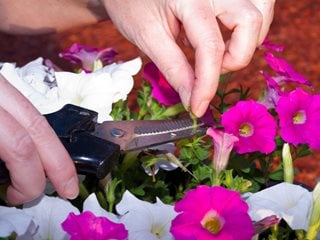How & When to Deadhead Petunias
Learn what you need to know about deadheading petunias: from when to deadhead to how to deadhead—and everything in between.
Photo by: BHamms / Shutterstock.
Petunias are a wildly popular annual for a variety of reasons: they are easy to care for, heat-tolerant, and vigorous. Because they come in so many different colors, they can fit in with just about any gardening style. Read on to learn the answer to one of the most common questions about petunias: do they need to be deadheaded?
WHY DEADHEAD A PLANT?
The process of deadheading involves removing spent flowers so energy is directed to creating more blooms during the growing season. If spent flowers are left on plants, the plant’s energy goes toward forming seeds rather than creating more flowers. Deadheading keeps plants blooming longer.
Important: Not all plants require deadheading, and some should not be deadheaded. Be sure to do your research before deadheading your plant.
SHOULD YOU DEADHEAD PETUNIAS?
While it’s not required, petunias are one of many plants that benefit from deadheading. The process of deadheading is time-consuming, but overall, your petunia plant will have a healthier appearance if you deadhead. If you do deadhead, your plant will keep producing blooms practically all summer long.
DOES DEADHEADING PETUNIAS PRODUCE MORE FLOWERS?
Yes. When you deadhead petunia plants, you ensure that the plants direct their energy toward creating more blooms. Otherwise, the energy will be directed towards helping the dead flowers produce seeds.
HOW TO DEADHEAD PETUNIAS?
Simply use your thumb and forefinger to pinch off spent blooms or use pruning shears or scissors if you prefer.
WHERE DO YOU CUT WHEN DEADHEADING PETUNIAS?
Remove the dead bloom, and make sure to get the base of the flower with it. Don’t just remove the petals—the base is where the seeds are. If you don’t remove the base of the flower, you’ll end up with a dried seed pod instead of a new bloom.
You don’t need to cut off much of the petunia stems, but if they look ratty, you can cut the stems below the flower and above green, healthy-looking foliage. If you think your petunia plants need more than just deadheading to freshen them up, read more about how and when to prune your petunias.
WHEN SHOULD YOU DEADHEAD PETUNIAS?
There is no hard and fast rule for when exactly to deadhead petunias, but generally you can remove the petunia bloom when it begins to look spent. This is typically around mid-summer.
You don’t have to remove them all at one time. If your petunia plant is in a spot that you walk by regularly, make it a habit to check for dead blooms and remove them as you see them.
Learn more: A Gardener's Guide to Deadheading








